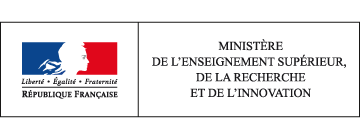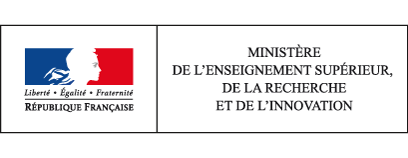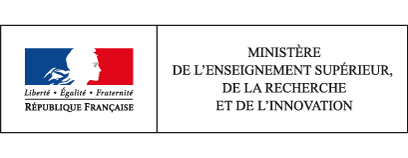MENESR-DGESIP/DGRI-SIES
Ministère de l'Enseignement supérieur, de la Recherche et de l'Innovation
Direction générale de l'enseignement supérieur et de l'insertion professionnelle
Direction générale de la recherche et de l'innovation
Service de la coordination des stratégies de l'enseignement supérieur et de la recherche
Sous-direction des systèmes d'information et des études statistiques - SIES
1 rue Descartes, 75231 Paris Cédex 05
http://www.enseignementsup-recherche.gouv.fr/
This source is used in these chapters:
During 2015-16, 711,000 students received at least one form of financial aid, i.e. around 36% of the population concerned. Financial and social support for students reached nearly 6.1 billion euros in 2015, 61% of which was direct aid from the State. [read more]
In 2015, 2,551,000 students enrolled in higher education, eight times as many as in 1960. Today, a little over six in ten students enrol at university. This share has however decreased over the last 50 years due to the diversification of the training on offer. [read more]
70.1% of general baccalauréat holders enrolled at university, i.e. three points less than in 2000. More than one in two technological baccalauréat holders enrolled in a short vocational course (STS or IUT). STS were the preferred course for vocational baccalauréat holders, as 27.8% enrolled in them, i.e. 2.4 points more than in 2014. This year saw a marked rise in dual CPGE-university enrolments. Comparisons could therefore not be made between 2015 and previous years in terms of university entrance. [read more]
In 2015, general baccalauréat holders represented 79.7% of new baccalauréat holders enrolled in . This rate dropped to 78.1% when dual CPGE enrolments were excluded. 43% of new entrants to short STS courses were technological baccalauréat holders and 35% were vocational baccalauréat holders. [read more]
There were 2,551,100 enrolments in higher education at the start of the 2015-2016 academic year. This was an increase of 3.2% in student enrolments over the previous year. The number of young people embarking on higher studies has risen hugely in five years. [read more]
Women outnumber men in higher education, but are less likely to enrol in selective or scientific courses and are in the minority in PhD programmes. In 2013, their unemployment rate three years after leaving was higher than men for nearly all levels of qualification, and their employment conditions were less favourable. [read more]
In higher education in France, 310,000 students are foreign nationals, or one student in eight. Since 2000, the proportion of foreign students has increased from 8% to 12%. Three-quarters of foreign students study at university. [read more]
At university, 27% of students obtain their Bachelor's degree 3 years after enrolling in the first year and 39% after 3 or 4 years. These rates have changed little in recent years. Nearly three-quarters of Bachelor's degree graduates enrol on a Master's the following year. Pass rates for Master's degrees have significantly increased since 2007; around 53% of students now obtain their degree in two years and 65% in two or three years. [read more]
Gross domestic expenditures on experimental research and development (GERD) has grown at an average annual rate of 1.6% over the past 15 years. This growth was driven mainly by the dynamism of domestic R&D spending by enterprises (1.9% on average annually). GERD accounts for 2.24% of GDP in 2014, or 47.9 billion euros. The companies carry out 65% of the R&D work carried out on the national territory and finance 61% of the national R&D expenditure. [read more]
In 2014, half of intramural business expenditure on R&D (BERD) was focused on six industrial branches (‘Manufacture of motor vehicles’, ‘Manufacture of air and spacecraft and related machinery’, ‘Manufacture of basic pharmaceutical products and pharmaceutical preparations’, ‘Computer-related and information service activities’, ‘Professional, scientific and technical activities’ and ‘Manufacture of chemicals and chemical products’). In the public sector, dedicated research institutions (EPST and EPIC) carried out 54% of all R&D funded by intramural government expenditure (GOVERD). [read more]
In 2014, SMEs (including micro-firms) represented 17% of intramural business enterprise R&D expenditure (BERD), over half of which was invested in the service sector. Large enterprises, which accounted for 58% of BERD, focused three quarters of their R&D efforts in the high and medium-high technology industries. [read more]
In 2014, the gross domestic expenditure on R&D (GERD) of France's main public research institutions amounted to €9.1 billion, down by 1.1% in relation to 2013. These institutions carry out 55% of public research and are key stakeholders in research and development in France. The French National Centre for Scientific Research (CNRS) and the civil division of the French Alternative Energies and Atomic Energy Commission (CEA) conduct a third of public research, with GERD of €5.5 billion. [read more]
In 2014, budget allocations spent on public research totalled nearly €13 billion and funded 68% of all public research and development (R&D). Resources contributed by institutions themselves accounted for nearly €6 billion and for 32% of R&D funding for public research. [read more]
In 2014, local authorities devoted €1.3 billion to funding research and technology (R&T). This funding went in large part towards property transactions and technology transfer and innovation. Regional councils accounted for two-thirds of R&T funding, while municipalities were the second local contributor. [read more]
In 2016, the Inter-ministerial Mission for Research and Higher Education assigned budget allocations worth €13 billion to research and development. Around 80% of these allocations went to research and higher education institutions in the form of public service subsidies. 49% of this budget is dedicated to fundamental research [read more]
Businesses based in France fund around 55% of the country’s gross domestic expenditure on R&D (GERD). Total expenditure on R&D by firms is €36.8 billion, which is 85% funded by companies in France and 7% by the government. [read more]
In 2014, over half a million people were involved in research activity in France. Women represented 30% of all research personnel and 26% of researchers. The number of researchers, 266,700 full-time equivalent (FTE) in 2014, has increased by 15% in five years. The number of researchers increased more rapidly in business enterprises (21%) than in government (6%) over the period 2009-2014. [read more]
In 2014, women represented 30% of all research personnel, and a little over a quarter of researchers. Furthermore, 36% of government research personnel are women compared to 20% in business enterprises, a contrast that is not unique to France. The proportions differ according to the field of research, with the most women being present in medicine, chemistry and agronomy. [read more]
In 2013, almost 220,000 researchers were involved in R&D activity in business enterprises in France. This is a young population, with a low proportion of women (20%), the majority with an engineering degree. In business enterprises, only 12% of researchers have a PhD and 17% have a Master's degree. The socio-economic characteristics of researchers, however, depend on the company's sector of research. [read more]
At the start of the 2015-16 academic year, 74,450 students were enrolled on a PhD programme. The number of doctoral students enrolled has been falling since 2009. 14,500 PhDs were awarded, stable over the last three years. Approximately three PhD students out of 4 enrolled in the first year receive funding for their thesis. [read more]
'Young innovative company’ (YIC) status was introduced to encourage people to set up and expand SMEs that carry out R&D. In 2014, their intramural R&D expenditure totalled €916 million and was focused primarily within the service sector. [read more]
Intramural business enterprise expenditure on R&D (BERD) in the field of biotechnology totalled €3.0 billion in 2014, accounting for around 10% of BERD. The proportion of firms active in this field of research has remained stable compared to 2013, at 11%. Firms that specialise in biotechnology are mostly small enterprises. [read more]
In 2014, 20% of firms in France that carried out R&D in-house incurred R&D expenditure in the fields of new materials or nanotechnology. Overall research expenditure in these two fields was €3.6 billion in 2014, or 11.7% of total BERD. [read more]
Intramural expenditure on research and development by business enterprises on information and communication technology (ICT) amounted to €6.4 billion in 2014, i.e. 21% of all business intramural expenditure on R&D. There were 60,416 full-time equivalent employees in ICT research branches, of which 82% were researchers or R&D engineers. Government institutions provided much more limited support for R&D efforts in ICT. [read more]
In 2014, R&D expenditure devoted either directly or indirectly to environmental issues was estimated to be €5 billion, equivalent to 11% of France’s gross domestic expenditure on R&D. Half of expenditure on environmental research and development (excluding Energy and Transport) was incurred by businesses (compared with 20% in 2000). [read more]



